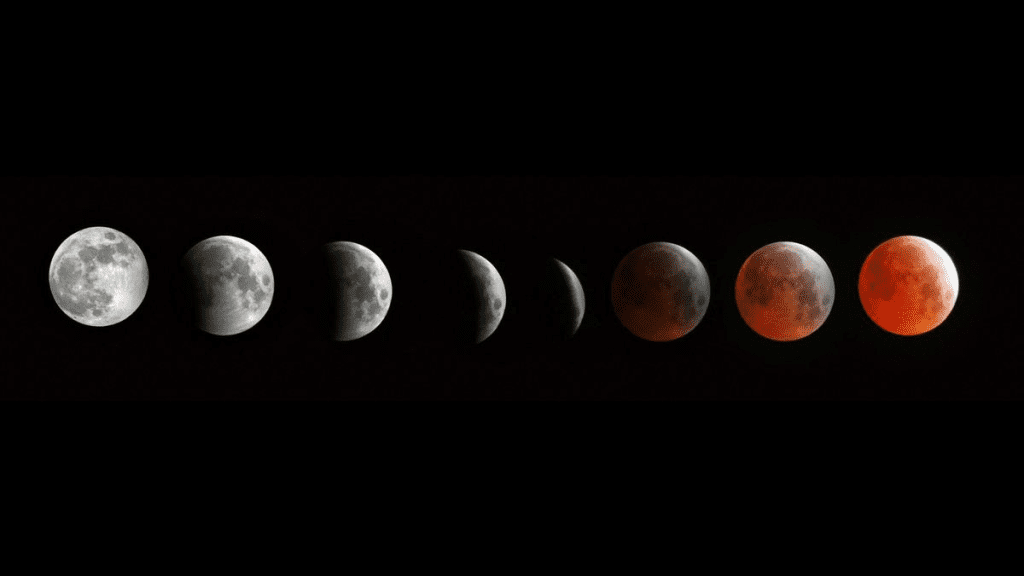Skywatchers, get ready! On the night of March 14-15, 2025, a total lunar eclipse will grace the skies, offering a breathtaking celestial spectacle. For approximately 65 minutes, the Moon will transition from its usual bright white glow to a dramatic deep red or brown hue, creating a mesmerizing sight known as the Blood Moon.
If you’re fascinated by astronomy or simply love witnessing nature’s wonders, this is an event you won’t want to miss. Whether you’re planning to observe it with the naked eye, through a telescope, or capture stunning photographs, this guide will provide all the essential details you need.
What Is a Total Lunar Eclipse?

A total lunar eclipse occurs when the Earth comes directly between the Sun and the Moon, casting a shadow that completely covers the Moon. Unlike a solar eclipse, which requires protective eyewear, a lunar eclipse is perfectly safe to view with the naked eye.
During this event, the Earth’s atmosphere filters sunlight, allowing only longer-wavelength red and orange light to reach the Moon. This is what gives the Moon its eerie red or brown appearance, often referred to as a Blood Moon.
When and Where Can You See It?
The total lunar eclipse will be visible from various parts of the world, but some regions will experience a better view than others. Here’s what you need to know:
- Best viewing locations: North America, South America, parts of Europe, and western Africa will get the best views of the full eclipse.
- Partial visibility: Some areas in Asia and eastern Africa will see only a partial eclipse.
- Total eclipse duration: Approximately 65 minutes of complete totality.
- Eclipse phases: The entire event, from the penumbral phase to the total eclipse and back, will last about three hours.
Video : Total Lunar Eclipse 2025: Will the Stunning Blood Moon Grace Your Skies?
If you’re in an area where visibility is limited due to weather conditions or location, don’t worry! Many astronomy organizations and space agencies will offer live-streams of the event.
What Causes the Blood Moon Effect?
One of the most fascinating aspects of a total lunar eclipse is the Blood Moon phenomenon. But why does the Moon turn red instead of disappearing completely?
This happens due to a process called Rayleigh scattering, the same mechanism responsible for red sunsets and sunrises. When the Earth blocks direct sunlight from reaching the Moon, some of the Sun’s light bends through the Earth’s atmosphere. The shorter wavelengths (blue and violet) scatter, while the longer red and orange wavelengths pass through and illuminate the Moon.
Depending on atmospheric conditions, the Moon can appear in shades ranging from deep red to copper or brown. If there are dust or volcanic particles in the atmosphere, the eclipse could take on an even darker hue.
How to Watch the Total Lunar Eclipse
Viewing a total lunar eclipse is easy and requires no special equipment. However, for the best experience, consider these tips:
- Find a dark location: The farther you are from city lights, the clearer your view will be.
- Check the weather: Cloudy skies can block your view, so make sure to check local forecasts.
- Use binoculars or a telescope: While the eclipse is visible to the naked eye, magnification enhances details like craters and surface textures.
- Capture the moment: If you love photography, use a DSLR camera with a tripod to get sharp images of the Moon’s color changes.
- Bring friends and family: Viewing an eclipse is a magical experience—share it with others!

Why This Lunar Eclipse Is Special
Not all lunar eclipses are created equal. Some are penumbral (where the Moon only passes through Earth’s outer shadow), while others are partial (where only part of the Moon is covered).
However, this event on March 14-15, 2025, is a total lunar eclipse, meaning the Moon will be completely engulfed by Earth’s shadow, creating an intense and dramatic visual effect.
Additionally, this eclipse comes at a time when interest in space and astronomy is at an all-time high, with upcoming missions to the Moon and Mars capturing global attention.
The Cultural and Historical Significance of Lunar Eclipses
Throughout history, lunar eclipses have been seen as mystical and sometimes ominous events. In ancient civilizations:
- The Incas believed a lunar eclipse occurred when a jaguar attacked the Moon.
- The Chinese thought a giant celestial dragon was devouring the Moon and would make loud noises to scare it away.
- Many Native American tribes viewed the event as a sign of change or transformation.
Today, lunar eclipses are understood scientifically, but they still inspire a sense of wonder and curiosity.
Video : Total Lunar Eclipse Blood Moon 14 March 2025 Your Horoscope with Gregory Scott
The Next Total Lunar Eclipses After March 2025
If you miss this one, don’t worry—there are more lunar eclipses coming in the future. The next total lunar eclipses will occur on:
- March 3, 2026
- December 31, 2028
- December 20, 2029
However, the March 2025 eclipse will be one of the longest and most visible in recent years, making it a must-watch event.
Final Thoughts: Don’t Miss This Celestial Event!
The March 14-15, 2025, total lunar eclipse is a rare and breathtaking natural event that reminds us of the beauty of our universe. Whether you’re an astronomy enthusiast or just someone who enjoys witnessing celestial wonders, this is an opportunity you won’t want to miss.
Mark your calendars, find a good viewing spot, and prepare to watch the Moon turn a stunning shade of red as it aligns perfectly with the Earth and Sun.
Are you excited for the eclipse? Share your thoughts in the comments and let us know where you’ll be watching from! Also, don’t forget to share this article with fellow space lovers so they can witness this incredible event, too.
My Husband Traded Our Family of Four for His Mistress — Three Years Later, I Met Them Again, and It Was Perfectly Satisfying

Three years after my husband abandoned our family for his glamorous mistress, I stumbled upon them in a moment that felt like poetic justice. It wasn’t their downfall that satisfied me. It was the strength I had found in myself to move forward and thrive without them.
Fourteen years of marriage, two wonderful kids, and a life I thought was solid as stone. But everything I believed in came crashing down one evening when Stan brought her into our home.
It was the beginning of the most challenging and the most transformative chapter of my life.

A woman standing in her house | Source: Midjourney
Before this happened, I was immersed in my routine as a mother of two kids.
My days were a blur of carpools, homework help, and family dinners. I lived for Lily, my spirited 12-year-old, and Max, my curious 9-year-old.
And though life wasn’t perfect, I thought we were a happy family.

A couple walking on the beach | Source: Pexels
The thing is, Stan and I had built our life together from scratch. We’d met at work and had instantly connected.
Soon after becoming friends, Stan proposed to me, and I had no reason not to say yes.
Over the years, we went through so many ups and downs, but one thing that stayed firm was our bond. I believed all the bad times we spent together had strengthened our bond, but I had no idea how wrong I was.
Lately, he’d been working late. But that’s normal, right?

A man using his laptop | Source: Pexels
Projects piled up at work, and deadlines loomed. These were just the sacrifices of a successful career. He wasn’t as present as he used to be, but I told myself he loved us, even if he was distracted.
I wish I knew that wasn’t true. I wish I knew what he’d been doing behind my back.
It happened on a Tuesday. I remember because I was making soup for dinner, the kind Lily loved with the tiny alphabet noodles.
I heard the front door open, followed by the unfamiliar sound of heels clicking on the floor.

A close-up shot of a woman’s heels | Source: Pexels
My heart skipped a beat as I glanced at the clock. It was earlier than usual for Stan to be home.
“Stan?” I called out, wiping my hands on a dish towel. My stomach tightened as I walked into the living room, and there they were.
Stan and his mistress.
She was tall and striking, with sleek hair and the kind of sharp smile that made you feel like prey. She stood close to him, her manicured hand resting lightly on his arm as if she belonged there.
Meanwhile, my husband, my Stan, looked at her with a warmth I hadn’t seen in months.

A man standing in his living room | Source: Midjourney
“Well, darling,” she said, her voice dripping with condescension as her eyes swept over me. “You weren’t exaggerating. She really let herself go. Such a shame. She’s got decent bone structure.”
For a moment, I couldn’t breathe. Her words sliced through me.
“Excuse me?” I managed to choke out.
Stan sighed like I was the one being unreasonable.
“Lauren, we need to talk,” he said, crossing his arms. “This is Miranda. And… I want a divorce.”

A woman in a black dress | Source: Midjourney
“A divorce?” I repeated, unable to process what he was saying. “What about our kids? What about us?”
“You’ll manage,” he said in a clipped tone as if discussing the weather. “I’ll send child support. But Miranda and I are serious. I brought her here so you’d know I’m not changing my mind.”
As if that wasn’t enough, he delivered the final blow with a casual cruelty I hadn’t thought him capable of.
“Oh, and by the way, you can sleep on the couch tonight or go to your mom’s place, because Miranda is staying over.”
I couldn’t believe what I was hearing.

A worried woman | Source: Midjourney
I felt so angry and so hurt, but I refused to give him the satisfaction of seeing me break.
Instead, I turned and stormed upstairs, my hands shaking as I grabbed a suitcase from the closet.
I told myself to stay calm for Lily and Max. As I packed their bags, tears blurred my vision, but I kept going.
When I walked into Lily’s room, she looked up from her book. She immediately knew something was not right.
“Mom, what’s going on?” she asked.

A girl reading a book | Source: Pexels
I crouched down beside her, stroking her hair.
“We’re going to Grandma’s for a little while, sweetheart. Pack a few things, okay?”
“But why? Where’s Dad?” Max chimed in from the doorway.
“Sometimes grown-ups make mistakes,” I said, keeping my voice steady. “But we’ll be okay. I promise.”
They didn’t press for more, and I was grateful. As we walked out of the house that night, I didn’t look back.
The life I had known was gone, but for my kids, I had to keep moving forward.

A woman standing in her house | Source: Midjourney
That night, as I drove to my mother’s house with Lily and Max fast asleep in the backseat, I felt the weight of the world on my shoulders. My mind raced with questions I didn’t have answers to.
How could Stan do this? What would I tell the kids? How would we rebuild our lives from the ashes of this betrayal?
When we arrived, my mom opened the door.
“Lauren, what happened?” she asked, pulling me into a hug.
But the words stuck in my throat. I just shook my head as tears streamed down my face.

A woman crying | Source: Pexels
In the days that followed, everything became a blur of legal paperwork, school drop-offs, and explaining the unexplainable to my children.
The divorce was swift, leaving me with a settlement that barely felt like justice. We had to sell the house, and my share of the money went toward buying a smaller place.
I got us a modest two-bedroom home. A home where I wouldn’t have to worry about getting betrayed.

A dining table in a small kitchen | Source: Pexels
The hardest part wasn’t losing the house or the life I thought I’d have. It was watching Lily and Max come to terms with the fact that their father wasn’t coming back.
At first, Stan sent child support checks like clockwork, but that didn’t last.
By the six-month mark, the payments stopped altogether, and so did the phone calls. I told myself he was busy, or maybe he needed time to adjust.
But as weeks turned into months, it became clear that Stan wasn’t just gone from my life. He’d walked out on the kids too.

A woman standing near a window | Source: Midjourney
I later learned through mutual acquaintances that Miranda had played a significant role in this. She had convinced him that staying in touch with his “old life” was a distraction.
And Stan, ever eager to please her, had gone along with it. But when financial troubles began to creep in, he didn’t have the courage to face us.
It was heartbreaking, but I had no choice but to step up for Lily and Max. They deserved stability, even if their father couldn’t provide it.
Slowly, I began to rebuild—not just for them, but for myself.

A woman working on her laptop | Source: Pexels
Three years later, life had settled into a rhythm I cherished.
Lily was in high school now and Max had taken his love for robotics to the next level. Our little home was filled with laughter and warmth, and it showed how far we’d come.
Our past no longer haunted us.
At that point, I thought I’d never see Stan again, but fate had other plans.

A woman standing in a room | Source: Midjourney
It was a rainy afternoon when everything came full circle.
I had just finished grocery shopping and was juggling bags in one hand and my umbrella in the other when I noticed them. Stan and Miranda were seated at a shabby outdoor café across the street.
And it looked like time had not been kind to either of them.
Stan looked haggard. His once-tailored suits were replaced by a wrinkled shirt and a tie that hung awkwardly loose around his neck.
His hair was thinning, and the wrinkles on his face were proof of his exhaustion.

A close-up shot of a man | Source: Midjourney
Miranda, still dressed in designer clothes, looked polished from afar, but up close, the details told another story. Her dress was faded, her once-luxurious handbag scuffed, and her heels worn down to the point of fraying.
Upon spotting them, I was unsure whether to laugh, cry, or keep walking.
But something kept me rooted to the spot. I guess it was curiosity.
As if sensing my presence, Stan’s eyes darted up and locked with mine. For a split second, his face lit up with hope.

A man smiling | Source: Midjourney
“Lauren!” he called, scrambling to his feet and nearly knocking over his chair. “Wait!”
I hesitated but decided to approach, carefully setting my groceries down under the awning of a nearby storefront.
Meanwhile, Miranda’s expression soured the moment she saw me. Her eyes flickered away as if avoiding a confrontation she knew she couldn’t win.
“Lauren, I’m so sorry for everything,” Stan blurted, his voice cracking. “Please, can we talk? I need to see the kids. I need to make things right.”

A man talking to his ex-wife | Source: Midjourney
“Make things right?” I asked. “You haven’t seen your kids in over two years, Stan. You stopped paying child support. What exactly do you think you can fix now?”
“I know, I know,” he began. “I messed up. Miranda and I…” He glanced at her nervously. “We made some bad decisions.”
“Oh, don’t blame this on me,” Miranda snapped, finally breaking her silence. “You’re the one who lost all that money on a ‘surefire’ investment.”
“You’re the one who convinced me it was a good idea!” Stan shot back at her.

An angry man looking straight ahead | Source: Midjourney
Miranda rolled her eyes.
“Well, you’re the one who bought me this,” she said, gesturing to her scuffed designer bag, “instead of saving for rent.”
I could feel the tension between them. It felt like years of resentment were now bubbling to the surface.
For the first time, I saw them not as the glamorous couple who had destroyed my marriage, but as two broken people who had destroyed themselves.

A woman looking straight ahead | Source: Midjourney
Finally, Miranda stood, adjusting her faded dress with a look of disgust.
“I stayed because of the child we had together,” she said coldly, her words directed more at me than at Stan. “But don’t think for a second I’m sticking around now. You’re on your own, Stan.”
With that, she walked away, her heels clicking against the pavement, leaving Stan slumped in his chair. He watched her go and didn’t once stop her. Then, he turned back to me.
“Lauren, please. Let me come by. Let me talk to the kids. I miss them so much. I miss us.”

A man talking to a woman | Source: Midjourney
I stared at him for a long moment, searching his face for any trace of the man I had once loved. But all I saw was someone I barely recognized. A man who had traded everything for nothing.
I shook my head.
“Give me your number, Stan,” I said. “If the kids want to talk to you, they’ll call. But you’re not walking back into my house.”
He flinched at the finality in my tone but nodded, scribbling his number on a scrap of paper.

A worried man | Source: Midjourney
“Thank you, Lauren,” he said. “I-I’d be grateful if they call me.”
I tucked it into my pocket without looking at it and turned away.
As I walked back to my car, I felt a strange sense of closure. To be honest, it wasn’t revenge. But it was the realization that I didn’t need Stan to regret his choices for me to move on.
My kids and I had built a life full of love and resilience, and no one could take that away.
And for the first time in years, I smiled. Not because of Stan’s downfall, but because of how far we had come.

A woman standing outdoors | Source: Midjourney
If you enjoyed reading this story, here’s another one you might like: Between her dying father and a sick child, a pregnant Penelope thought she’d seen life’s worst… until she saw a message from her best friend on her husband’s phone: “I’m assuming since there hasn’t been an angry pregnant lady on my doorstep, you haven’t told her about us?”
This work is inspired by real events and people, but it has been fictionalized for creative purposes. Names, characters, and details have been changed to protect privacy and enhance the narrative. Any resemblance to actual persons, living or dead, or actual events is purely coincidental and not intended by the author.
The author and publisher make no claims to the accuracy of events or the portrayal of characters and are not liable for any misinterpretation. This story is provided “as is,” and any opinions expressed are those of the characters and do not reflect the views of the author or publisher.



Leave a Reply